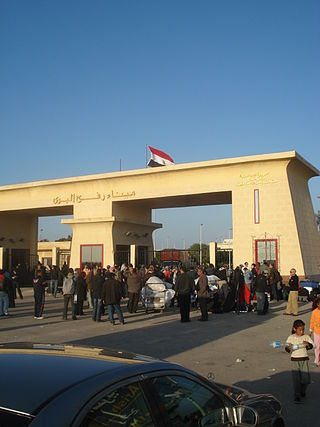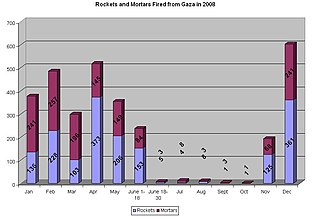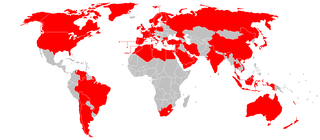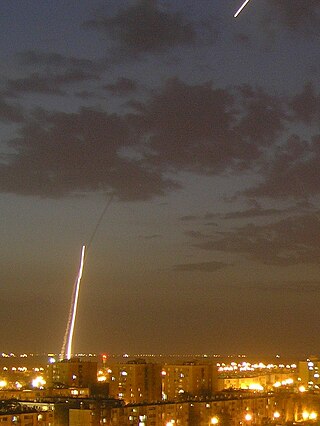Related Research Articles

The Gaza Strip, or simply Gaza, is a polity and the smaller of the two Palestinian territories. On the eastern coast of the Mediterranean Sea, Gaza is bordered by Egypt on the southwest and Israel on the east and north.

The Gaza Strip smuggling tunnels are smuggling tunnels that had been dug under the Philadelphi Route along the Egypt–Gaza border. They were dug to subvert the blockade of the Gaza Strip to smuggle in fuel, food, weapons and other goods into the Gaza Strip. After the Egypt–Israel peace treaty of 1979, the town of Rafah, in the southern Gaza Strip, was split by this buffer zone. One part is located in the southern part of Gaza, and the smaller part of the town is in Egypt. After Israel withdrew from Gaza in 2005, the Philadelphi Corridor was placed under the control of the Palestine Authority until 2007, when Hamas seized power in 2007, and Egypt and Israel closed borders with the Gaza Strip.

Israel Electric Corporation is the largest supplier of electrical power in Israel and the Palestinian territories. The IEC builds, maintains, and operates power generation stations, sub-stations, as well as transmission and distribution networks in Israel.

The 2006 Gaza–Israel conflict, known in Israel as Operation Summer Rains, was a series of battles between Palestinian militants and the Israel Defense Forces (IDF) during summer 2006, prompted by the capture of Israeli soldier Gilad Shalit by Palestinian militants on 25 June 2006. Large-scale conventional warfare occurred in the Gaza Strip, starting on 28 June 2006, which was the first major ground operation in the Gaza Strip since Israel's unilateral disengagement plan was implemented between August and September 2005.

The Rafah Border Crossing or Rafah Crossing Point is the sole crossing point between Egypt and Palestine's Gaza Strip. It is located on the Egypt–Palestine border. Under a 2007 agreement between Egypt and Israel, Egypt controls the crossing but imports through the Rafah crossing require Israeli approval.

On 23 January 2008, Hamas militants in the Gaza Strip set off an explosion near the Rafah border crossing, destroying part of the 2003 wall. The United Nations estimates that as many as half the 1.5 million population of the Gaza Strip crossed the border into Egypt seeking food and supplies. Due to fears that militants would acquire weapons in Egypt, Israeli police went on increased alert.
The Gaza–Israel conflict is a localized part of the Israeli–Palestinian conflict beginning in 1948, when 200,000 Palestinians fled or were expelled from their homes, settling in the Gaza Strip as refugees. Since then, Israel has fought 15 wars against the Gaza Strip. The number of Gazans killed in the most recent 2023 war — 27,000 — is higher than the death toll of all other wars of the Arab-Israeli conflict.

A blockade has been imposed on the movement of goods and people in and out of the Gaza Strip following Hamas's takeover in 2007, led by Israel and supported by Egypt. The blockade's current stated aim is to prevent the smuggling of weapons into Gaza, although previously stated motivations have included exerting economic pressure on Hamas. Human rights groups have described the blockade as illegal and a form of collective punishment as it restricts the flow of essential goods, contributes to economic hardship, and limits the freedom of movement for Gaza's residents. The blockade and its effects have led to the territory being described as an "open-air prison".

The 2008 Israel–Hamas ceasefire was an Egyptian-brokered six-month Tahdia "for the Gaza area", which went into effect between Hamas and Israel on 19 June 2008. According to the Egyptian-brokered agreement, Israel promised to stop air strikes and other attacks, while in return, there would not be rocket attacks on Israel from Gaza. Once the ceasefire held, Israel was to gradually begin to ease its blockade of Gaza.
There are multiple humanitarian, medical, economic, and industrial effects of the 2008–2009 Gaza War which started with the Israeli air strikes on 27 December 2008 and ended on 18 January with a cease-fire implemented unilaterally by Israel, and later the same day by Hamas and other Palestinian factions. The cease-fire followed twenty-two days of bombardment by land, sea and air which left over 1,300 Palestinians dead and over 5,000 injured, and the death of 13 Israelis. The United Nations Development Programme warned that there will be long-term consequences of the attacks on Gaza because the livelihoods and assets of tens of thousands of Gaza civilians have been affected.

Following the 2008–2009 Israel–Gaza conflict, an international conference took place on 2 March 2009 in Sharm El-Sheikh, Egypt, where donor countries and international bodies pledged almost US$4.5 billion for humanitarian and reconstruction aid for the Gaza Strip. These funds bypassed Hamas, with the PA in collaboration with the donor community taking the lead in delivering and distributing the funds. Damage from the Israeli offensive was estimated to be almost $2 billion. However, actual transfers of aid had been beset by difficulties.

The economy of the Gaza Strip was dependent on small industries and agriculture. After years of decline, the Gaza economy experienced some growth in the late 2000s, boosted by foreign aid. According to the International Monetary Fund, the economy grew 20 percent in 2011, and the per capita gross domestic product increased by 19 percent.

Egypt–Palestine relations are the bilateral relations between the Arab Republic of Egypt and the State of Palestine. Egyptian President Gamal Abdel Nasser was a strong supporter of the Palestinian cause and he favored self-determination for the Palestinians. Although the Egyptian government has maintained a good relationship with Israel since the Camp David Accords, most Egyptians strongly resent Israel, and disapprove of the close relationship between the Israeli and Egyptian governments.

In November 2012, the Israel Defense Forces (IDF) launched Operation Pillar of Defense, which was an eight-day campaign in the Hamas-governed Gaza Strip, beginning on 14 November 2012 with the killing of Ahmed Jabari, chief of the Gaza military wing of Hamas, by an Israeli airstrike.

The governance of the Gaza Strip since the Hamas takeover of the Gaza Strip in June 2007 has been carried out by Hamas. The Hamas government in Gaza was led by Ismail Haniyeh from 2007 until February 2017, when Haniyeh was replaced as leader of Hamas in the Gaza Strip by Yahya Sinwar. As of November 2023, Yahya Sinwar continues to be the leader of Hamas in the Gaza Strip. Due to the ongoing Israel–Hamas war, Hamas lost control of most of the northern part of the Gaza Strip.

The 2014 Gaza War, also known as Operation Protective Edge, and Battle of the Withered Grain, was a military operation launched by Israel on 8 July 2014 in the Gaza Strip, a Palestinian territory that has been governed by Hamas since 2007. Following the kidnapping and murder of three Israeli teenagers in the West Bank by Hamas-affiliated Palestinian militants, the Israel Defense Forces (IDF) initiated Operation Brother's Keeper, in which some 350 Palestinians, including nearly all of the active Hamas militants in the West Bank, were arrested. Hamas subsequently fired a greater number of rockets into Israel from the Gaza Strip, triggering a seven-week-long conflict between the two sides. It was one of the deadliest outbreaks of open conflict between Israel and the Palestinians in decades. The combination of Palestinian rocket attacks and Israeli airstrikes resulted in over two thousand deaths, the vast majority of which were Gazan Palestinians. This includes a total of six Israeli civilians who were killed as a result of the conflict.
The following is a timeline of the 2014 Gaza War. Over 2014, Palestinians suffered the highest number of civilian casualties since the Six-Day War in 1967, according to a United Nations report, given the July–August conflict, and rising tolls in the West Bank and East Jerusalem. A spike in Israeli casualties also occurred. 2,256 Palestinians and 85 Israelis died, while 17,125 Palestinians, and 2,639 Israelis suffered injuries.
Palestine produces no oil or natural gas and is predominantly dependent on the Israel Electric Corporation (IEC) for electricity. According to UNCTAD, the Palestinian Territory "lies above sizeable reservoirs of oil and natural gas wealth" but "occupation continues to prevent Palestinians from developing their energy fields so as to exploit and benefit from such assets." In 2012, electricity available in West Bank and Gaza was 5,370 GW-hour, while the annual per capita consumption of electricity was 950 kWh. National sources only produce 445 GWh of electricity, supplying less than 10% of demand. The only domestic source of energy is the disputed Gaza Marine gas field, which has not yet been developed. Palestinian energy demand increased rapidly, increasing by 6.4% annually between 1999 and 2005. Future consumption of electricity is expected to reach 8,400 GWh by 2020 on the expectation that consumption will increase by 6% annually.
On 9 October 2023, Israel intensified the blockade of the Gaza Strip in response to the beginning of the Israel–Hamas war and attacks in Israel by Hamas militants. Israel announced a "total blockade", blocking the entry of food, water, medicine, fuel and electricity. Israel has said that the Gaza Strip blockade would not be lifted until the hostages, who were abducted by Hamas, are safely returned to their homes. Hamas had announced that it would release all Israeli hostages in exchange for the release of all Palestinian prisoners by Israel. On 18 October 2023, United States President Joe Biden announced that Israel and Egypt had agreed to allow humanitarian aid to enter the Gaza Strip, with the first supplies entering on 21 October 2023. The blockade resulted in a humanitarian crisis.
References
- ↑ "Gaza's Electricity Crisis: The Impact of Electricity Cuts on the Humanitarian Situation" (PDF). United Nations Office for the Coordination of Humanitarian Affairs. May 2010. Archived from the original (PDF) on 15 August 2014.
- ↑ ‘Gaza Infrastructure Nearing Collapse’, JPost, January 2017
- ↑ Seeing no end to power crisis, Gazans turn to the sun, Reuters, March 2016
- ↑ Gaza’s electricity crisis sheds light on gap between social classes, al-Monitor, March 2016
- ↑ "Why Abbas asked Israel to cut power to Gaza", BBC News , 27 April 2017
- ↑ "Palestinian Authority says resuming payment for Gaza's Israeli electricity", Reuters, 4 January 2018
- 1 2 The humanitarian impact of Gaza’s electricity and fuel crisis Archived 2017-03-22 at the Wayback Machine , UN OCHA, March 2014
- ↑ Gaza conflict one year on: The power plant
- 1 2 Egyptian power lines to Gaza down, Middle East Monitor, April 2017
- ↑ Oren Liebermann; Talal Abu Rahma (17 April 2017). "Gaza faces crisis as power plant runs out of fuel". CNN. Retrieved 15 June 2017.
- 1 2 Gewirtz, Jason (15 May 2017). "Israel and Gaza: An electricity dispute makes a tense situation worse". CNBC.com. Retrieved 15 June 2017.
- ↑ Egypt shuts non-functioning power lines to Gaza for maintenance – report, Times of Israel, Dov Lieber, 12 June 2017
- ↑ "Israel reduces Gaza electricity after PA refuses to pay". JPost.com. 25 May 2017. Retrieved 15 June 2017.
- ↑ Israel cuts Gaza electricity after Palestinian president says he will no longer pay the bill for Hamas, Telegraph, 12 June
- ↑ "Israel reduces power supply to Gaza, as Abbas pressures Hamas". Reuters. 12 June 2017. Retrieved 15 June 2017.
- 1 2 Egypt said to offer Hamas electricity in exchange for 17 wanted men, Times of Israel, 13 June 2017
- ↑ Gaza Power Cuts Boost Tension With Israel, Ha'aretz, 12 June 2017
- ↑ "UN: Fatah-Hamas 'tug-of-war' could lead to fresh conflict in Gaza". JPost.com. 27 May 2017. Retrieved 15 June 2017.
- ↑ Hamas: Cutting electricity to Gaza would be 'catastrophic', ABC News (AP Newswire), 12 June 2017
- ↑ "Egypt offers Gaza electricity in exchange for crackdown on security at border". JPost.com. 13 June 2017. Retrieved 15 June 2017.
- ↑ Egypt said to ease Gaza power crisis with emergency fuel supply, 20 June 2017, Times of Israel
- ↑ Gaza's beaches unseasonably empty, Al-Monitor, Rasha Abou Jalal, 27 July 2017
- ↑ 'The worst it's been': children continue to swim as raw sewage floods Gaza beach, Guardian, Peter Beaumont, 31 July 2017
- ↑ Gaza Sewage Forces Shutdown of Israeli Beach, JPost, Sharon Udasin and Tova Lazaroff, 6 July 2017
- ↑ Gaza sewage water polluting Israeli groundwater, YNET, Matan Tzuri, 19 July 2017
- ↑ U.N. urges end to Gaza crisis in punishing summer heat, Reuters, 11 August 2017
- ↑ "Winter 2017: Living without electricity just an hour and a half away from Tel Aviv". www.BTselem.org. Retrieved 15 June 2017.
- ↑ "Israel cannot shirk its responsibility for Gaza's electricity crisis". www.BTselem.org. Retrieved 15 June 2017.
- ↑ al-Mughrabi, Nidal (18 August 2020). "Gaza's lone power plant shuts down amid tension with Israel". Reuters . Retrieved 13 October 2023.
- 1 2 "Israel says high voltage power lines supplying Gaza Strip with electricity damaged". Al Arabiya English. 16 May 2021. Retrieved 20 May 2021.
- ↑ "Electric company union: No repair to Gaza power lines until captives returned". www.timesofisrael.com. 20 May 2021. Retrieved 13 October 2023.
- ↑ "Israel cuts electricity supply to Gaza". www.timesofisrael.com. 7 October 2023. Retrieved 7 October 2023.
- ↑ "Mains electricity in Gaza has gone out". www.bbc.com. Retrieved 11 October 2023.
- ↑ Gaza's Only Power Plant Knocked Out, Arutz7, July 2014
- ↑ Israel, Turkey eager to rebuild Gaza, Globes English, June 2016
- ↑ "Palestinian Authority halts payments for Israeli electricity to Gaza: Israel". Reuters. 27 April 2017. Retrieved 15 June 2017.
- ↑ "Hamas blames Abbas for Gaza power plant shutdown". JPost.com. 18 April 2017. Retrieved 15 June 2017.
- ↑ With Only Three Hours of Electricity a Day, Gaza Is 'On Verge of Explosion', Ha'aretz, January 2017